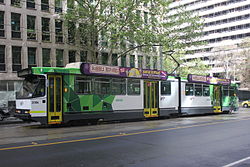B-class Melbourne tram
| B-class | |
|---|---|

|
|
| Manufacturer | Comeng/ABB |
| Assembly | Dandenong |
| Constructed | 1984-1994 |
| Number built | 132 |
| Number in service | 131 |
| Fleet numbers | B1 2001-B1 2002 B2 2003-B2 2132 |
| Capacity | B1/B2: 76 B2 (Apollo): 40 (Seated) B1/B2: 110 B2 (Apollo): 120 (Standing) |
| Depot(s) |
Brunswick Camberwell Essendon Glenhuntly Preston |
| Specifications | |
| Train length | B1: 23.50 m (77 ft 1 in) B2: 23.63 m (77 ft 6 in) |
| Width | B1: 2.67 m (8 ft 9 in) B2: 2.77 m (9 ft 1 in) |
| Height | B1: 3.35 m (11 ft 0 in) B2: 3.65 m (12 ft 0 in) |
| Doors | 6 |
| Articulated sections | 1 |
| Wheelbase | 1.8 m (5 ft 11 in) |
| Weight | B1: 32.5 t (32.0 long tons; 35.8 short tons) B2: 34.0 t (33.5 long tons; 37.5 short tons) |
| Traction motors | 2 x AEG ABS 3322 195 kW (261 hp) |
| Electric system(s) | 600 V DC catenary |
| Current collection method | Pantograph |
| Bogies | Duewag |
| Track gauge | 1,435 mm (4 ft 8 1⁄2 in) standard gauge |
The B-class are a two-section, three-bogie articulated class of trams that operate on the Melbourne tram network. Following the introduction of two B1-class prototype trams in 1984 and 1985, a total of 130 B2-class trams were built by Comeng (later ABB), Dandenong.
They were developed for the conversion of the St Kilda and Port Melbourne railway lines to light rail, and introduced by the Metropolitan Transit Authority, and later the Public Transport Corporation between 1984 and 1994.
In preparation of the conversion of the St Kilda and Port Melbourne railway lines to light rail, two prototype B1-class trams were built in 1984 and 1985 at the end of an order for A2-class trams. They were followed by 130 B2-class trams built between 1987 and 1994. All were built by Comeng and later ABB in Dandenong. They were the first articulated trams on the Melbourne tram network, and the B2-class were the first air-conditioned trams.
On the request of the Victorian transport minister, who wished the last of the B-class order to be low-floor trams, an articulated low-floor design was developed by Comeng from 1989. The tram was to ostensibly utilise the components from the B-class and be partially low-floor, with internal stairs over the bogies. The design progressed quite far, with concept art, design schematics, and a mock up produced, and work on the first body shell commenced.
The project was cancelled in 1990, with the new transport minister opting to finish the full B-class order instead of the low-floor variant; this was on the back of disputes between Comeng and the Public Transport Corporation, a cabinet reshuffle, and ABB's acquisition of Comeng.
...
Wikipedia
